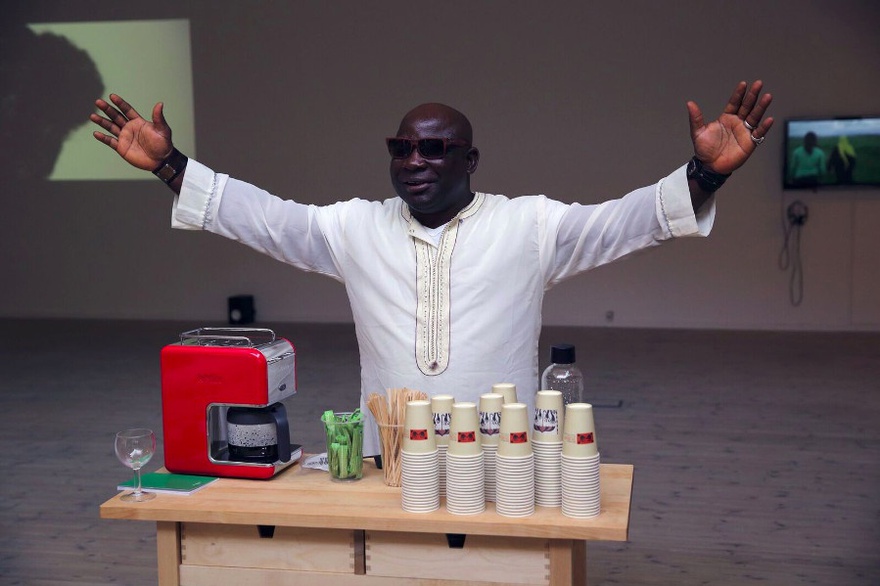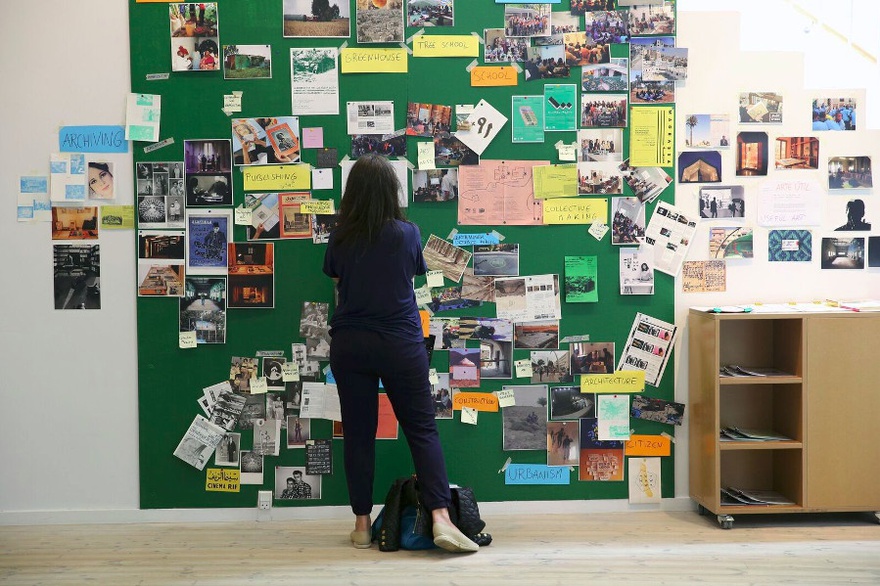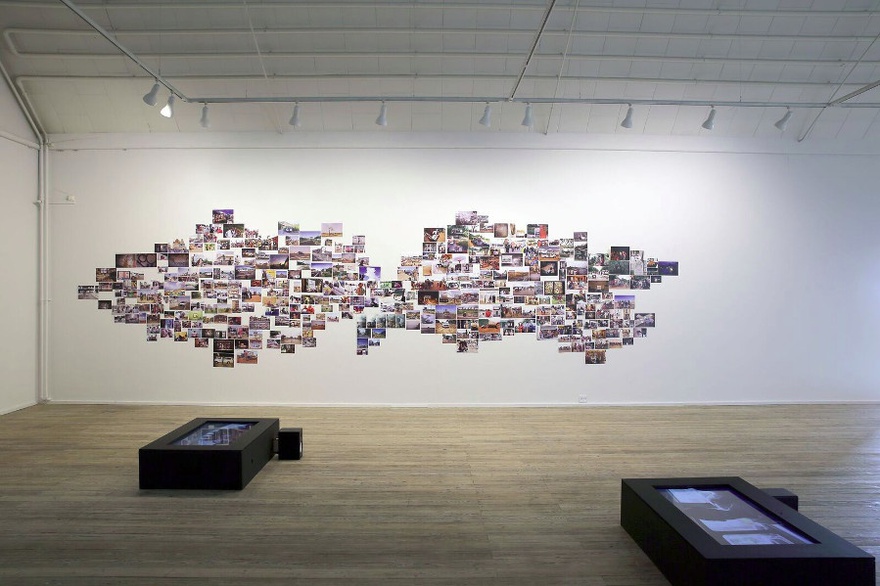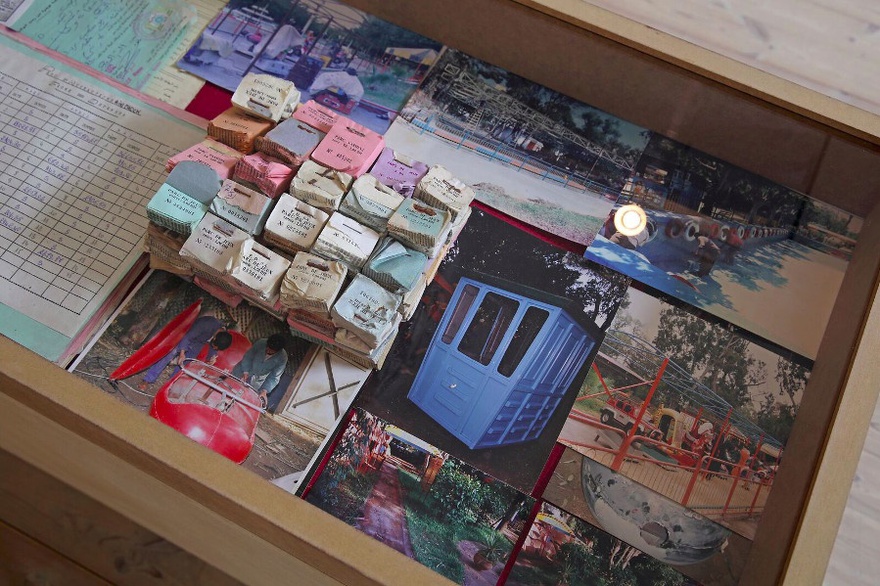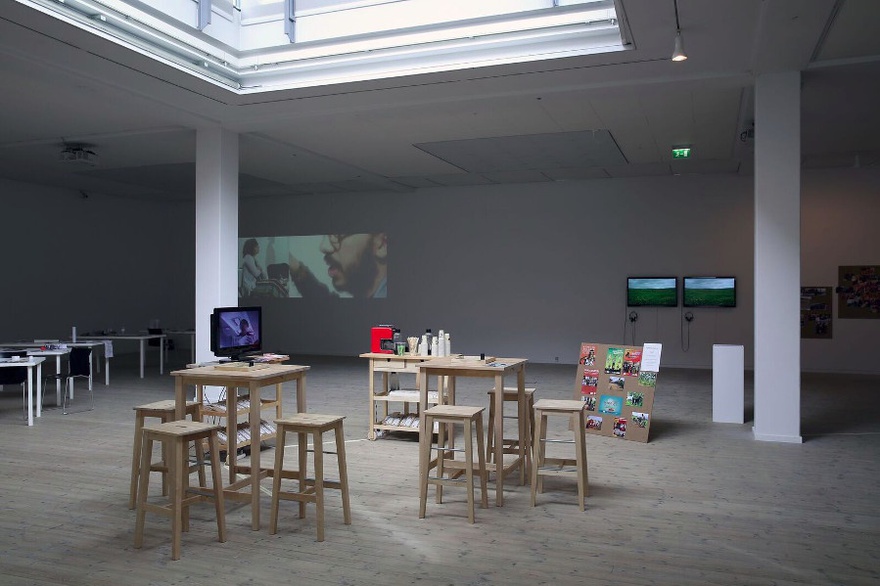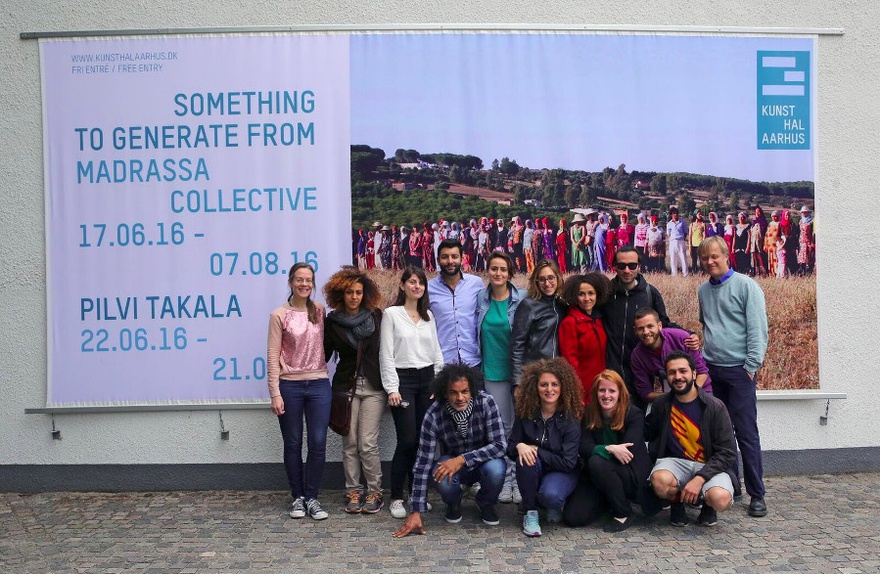Interviews
The Making of a Collective
MADRASSA Collective in conversation with Antonia Alampi
In October 2015, I travelled to Casablanca to lead a workshop in the context of MADRASSA, a five-day educational programme on curatorial practices with a focus on North Africa and the Middle East. The program was initiated by L'Atelier de l'Observatoire, a non-profit institution founded by Léa Morin and Mohamed Fariji, located in the rural lands of the region of Bouskoura, 32 kilometres away from Casablanca. As part of the pedagogical activities of the programme, its students (15 in total) were asked to apply together to an open call for exhibition proposals that Kunsthal Aarhus in Denmark had launched on the theme of collective making, and which encouraged applications from North, East and West Africa and the Middle East. The initiative brought together a group of participants, who in winning the call, became more than a temporary venture, adopting the name of the programme that brought them together: MADRASSA collective. This conversation is a reflection on their first co-curated exhibition Something to Generate From, which ran from 17 June to 7 August 2016 at Kunsthal Aarhus – a project that focused on institutional and collective practices. In this conversation, we talk about their experience, curatorial approach and methodologies, and the challenges implied in the making of a collective composed of 8 people living in different countries but with a strong commitment and dedication to exploring the specifics of curatorial and artistic research in Africa and the Middle East.
Antonia Alampi: Let's start from the very beginning of how MADRASSA collective evolved. I had the pleasure to be one of the contributors to the MADRASSA educational program, along with Hicham Khalidi, Filipa Ramos, Yasmina Reggad, Berenice Saliou, Léna Monnier and Olga Rozenblum, among others. It was directed towards young curators, researchers, artists and other cultural producers based or interested in the cultural context of the Middle East and Africa. Was there a sense of urgency following your participation in the workshop that led to the establishment of the collective on a permanent basis?
Madrassa Collective: The workshop in Casablanca was a rare opportunity for each of us to meet other curators and art practitioners active in the region, which drove us to realize how important it was to develop more 'horizontal' South-to-South professional exchanges and collaborations within culture. We all have different backgrounds: some of us studied art history, others curating, architecture or international political economics for instance, and we are involved in various activities in fields such as cultural management, cinema, academic and independent research, among other disciplines. However, we are all driven by an urgent impulse, which is to put together our diverse skills and perspectives to engage with and reflect on curatorial practices and modern and contemporary art histories in the Middle East and Africa. The driving force of our collective is to resist and reconsider the usual postcolonial paradigms that bring into opposition a so-called centre and peripheries, both in art historiography, theory, and in the manifestations of artistic projects.
AA: Your first project as a collective is the exhibition Something to Generate From at Kunsthal Aarhus, which ran from 17 June to 7 August 2016. The exhibition was the result of an open call launched by Kunsthal Aarhuas as part of its programme Collective Making in 2016, which had a specific focus on Africa and the Middle East. But instead of exhibiting artworks you invited a selected number of institutions, mostly from Africa, that have emerged in the last decade, such as MASS Alexandria (Egypt), The Collective Museum (Morocco), Bandjoun Station (Cameroon), and Algerian Pavilion (Algeria), among others. What was presented as part of the exhibition? What curatorial approach and methods did you adopt as a collective?
MC: Every project resulted from a long exchange between us as facilitators and each initiative aimed at identifying the most suitable way to represent, in a limited time frame and in a radically different geographical and institutional context, their identity. Each project had a totally different display format, responding to their focus and methodology. But in every instance, we really wanted to imagine displays that would not be archives or documents of a project. For instance, with Invisible Borders, a collective of photographers, video-makers and writers from Nigeria, whose core activity consists of undertaking and documenting road trips around the African continent, we attempted to visually, sonically and physically represent their travelling experience. Their intervention was organized around two elements: the first was of a five-metre long and two-metre high installation of photographs taken in different moments of their road-trips; the second, was video footage of their current expedition in Nigeria, displayed via three intermittent screens placed on the floor, plunging the visitor in the landscape and soundscape of Nigeria and offering an insight into the discussions the collective was having as they travelled.
A very different space was organized by Fehras Publishing Practices, who investigate the transformations of the Arabic language in relation to art and theoretical discourses. Their project starts from a rigorous collection of bilingual publications mainly issued by Arab art institutions, from which they noted new terms and formulations crafted to adopt, appropriate and adapt modern discourses. The ongoing dictionary of 'institutional terms' was presented through a slide projection, echoing a fictitious library consisting of wooden reproductions of the bilingual books, to highlight the symmetrical use of Arabic and English languages.
With Samia Henni, who is behind the Algerian Pavilion, we created the newspaper News from the Past, which proposed a revised version of the history of French colonial architecture in Algeria, and more precisely of a social housing plan implemented by the General Charles De Gaulle. Visitors could sit on fatboy lounge chairs and read the newspaper in front of a wall painting displaying slogans, such as: "Buildings may reveal a myriad of histories if we question their raison d'être", handwritten in black paint to evoke the graffiti that can be seen in the streets of Algiers while raising the audience's awareness about the political implications of architecture.
In the installation by Mass Alexandria – a space in Egypt mainly dedicated to art education – an interactive 'studio visit in absence of the artists' invited visitors to dig into boxes and go through objects, sketches, photographs and texts that are part of an on-going research by the young artists participating in the programme. A video guided the visitors: it was shot during the students' public presentations, and thus it also allowed audiences to remotely attend the sessions, and grasp the spirit of the school and its educational methods.
Another participative proposition was the mobile cafeteria by Bandjoun Station, which we conceived in collaboration with artist Barthélémy Toguo. Taking his agricultural project in Cameroon as a starting point, the installation took the shape of an informal cafeteria, with tables, stools, and board games, in which visitors were invited to taste and buy the coffee. Together we designed coffee pouches and paper cups, set a performance protocol, and most importantly defined selling prices which corresponds with the actual value of the farmers' work. This way, the project – led by a vision of art as a growth factor – aims at reinventing the rules of the agri-food and the art markets, and redefining the notions of commercial and artistic values. The cafeteria was of course an ideal form of mediation and circulation of the coffee produced in Bandjoun, as it meets Barthélémy Toguo's interest in participatory art and in what art critique Nicolas Bourriaud has called 'relational aesthetics'. We defined it as 'mobile' because even if it was originally conceived as part of Something to Generate From, we wanted it to travel further and meet international audiences. In October 2016 it was exhibited in London as part of the 1:54 art fair, and it will be presented at Rond-Point Projects in Marseille in December 2016.
The Collective Museum by Moroccan artist Mohamed Fariji engages with the politics of institution building, in which the artist is creating the design for a new museum dedicated to the collective memory of Casablanca in the city. The exhibition offered an opportunity to present the first iteration of the project. All the objects, documents, video and photographs presented were elements collected from an abandoned amusement park, which the artist brought back to life, through a performance during which he reactivated the carousels for the children of Casablanca. The Collective Museum is therefore a different kind of participative project, initiated by an artist while being dedicated to a city and involving a lot of diverse interlocutors – public authorities, local educational and social associations, political decision makers, and inhabitants. The display in the exhibition highlighted the role of the artist vis-à-vis cultural politics, heritage preservation as well as their contribution towards rethinking the cities' institutions and museums.
The space dedicated to l'Art Rue, an association initiating artistic and social projects within public space in Tunisia and founded by choreographers Selma and Soufiane Ouissi, was aimed at presenting the socially engaged and collective practice initiated by its founders using the project Laaroussa as a case-study. For this project, two contemporary dancers created an ephemeral collective with the complicity of other artists from different disciplines along with women potters from the rural area of Sejnan in Tunisia. The display of l'Art Rue sought to emphasize the deep relationship between the artistic and choreographic practice of its founders and their engagement with marginalized craftswomen in an attempt to re-activate a forgotten tradition. Laaroussa also works with a special horizontal structure, where the human exchange is as important as the artistic practice. Thus the result was the display of immaterial works of art such as the creative process of the 'hand choreography' inspired by the gestures of the women potters while making the clay dolls, but also a video piece of that experience and a documentary on the production of clay dolls.
AA: Why did you focus on institutions? Can you talk about the selection process for choosing the participating institutions, beyond the consideration of geographical location?
MC: The initial intention of Something to Generate From was to consider the practice of building institutions as an artistic process. Essentially, our question was: can we look at experimental institutional experiences as artworks, and present them as an exhibition? It was important to consider the regional perspective as part of the selection process and how these artist-led collective initiatives emerged throughout the last decades within their specific geopolitical contexts. Furthermore, through the framework of the 'institution' we wanted to highlight the issue of positioning art within the broader social sphere.
The title of the exhibition comes from Tania Bruguera's Introduction on Useful Art, a text that has been at the core of our reflections, specifically our engagement with the notion of institution in a lateral way: as a possible form of community structuring and as a space governed by informal norms established to meet specific needs in a given society or organization. As a matter of fact, all the projects included in the exhibition promote and initiate programmes that have a scope that transcends the contemporary art system. They question the conditions that make art possible and therefore stimulate an understanding of art as a locus to produce change, in the widest sense possible. As the title stresses, all the invited projects share an understanding of art as a 'generative' practice. Furthermore, by focusing on specific geographical, and socio-cultural territories, and by displaying these projects in Denmark, our intention was to question the notion of alterity vis-à-vis that of collectivity, hence the exhibition's focus on organizations rather than on individual artists. All the exhibited projects share an ambiguity regarding their status and their authorship, reinforced by the fact that while they all are first and foremost artistic initiatives, not all are led by artists. For example, the Algerian Pavilion was founded by Samia Henni, who is an architect and a researcher, and Mass Alexandria was founded by artist Wael Shawky and its programme is directed by theorist and curator Berit Schuck.
AA: Exposing contextual institutional practices to an audience that is geographically detached from those narratives, or has little knowledge about them, demands very careful considerations on how to relocate them in a meaningful way, without running the risk of flattening – or at worst exoticizing – their work. Can you tell me about how you dealt with your audience and what you found particularly challenging, or even disappointing, in retrospect? Is there anything you would do differently?
MC: Something to Generate From was indeed an interesting encounter between different cultures. Let us mention an extremely revealing anecdote. The Kunsthal's artistic director, Jacob Fabricius, invited a scholarfor a speech during the opening. He claimed to be a specialist of the Middle East and Africa, and he delivered a totally Eurocentric talk focusing on geopolitical issues. In particular, he referred to 'state violence' as a common denominator between the various countries he identified in the exhibition. In essence, he shared a distorted reading of the exhibition that led us to react immediately, prompting a conversation that allowed us to speak about the impact of colonialism on the region and cultural stereotyping that the exhibition didn't explicitly address. As such, this gave us an opportunity to clarify, with audiences, the seemingly obvious; such as the fact that Africa and the Arab world are not one single region and do not refer to a homogeneous area, that they are a multiplicity of cultural, social and political realities that share a colonial history that did not end with the formal independences of the countries but that continues via the incursion of neoliberal economics. These countries are often referred to as part of the global South, or as the 'Third World'. We, as curators, propose to consider the South not in the classical geopolitical meaning of the term – as a zone of poverty and exploitation – but as a region of creativity and agency which asserts the histories of colonialism that coexist and are shared across regions. The various initiatives exhibited in Something to Generate From demonstrate the effectiveness of this creativity and this agency, firmly rooted in rich territories and cultures. Unfortunately, the work of artists from these regions is often interpreted only through its political impact, and it was important to us to reaffirm that, even if it is important to take into consideration the highly contextual aspect of the exhibited projects in order to understand them fully, there is always a universal dimension to art.
The curatorial tours and the public programme, which mainly took place during the weekend of the opening, also played an important part in mediating the meaning of the exhibition. It gave a chance to most of the invited artists and participants to explain their work extensively. We also released a small publication providing further information on the cultural contexts and territories in which each exhibited project operates. Of course, it would have been preferable to spend more time on site and to connect more with the Danish contemporary art network and audiences, which would have required the presence of visitors' assistants who could speak to the audience and provide them with further explanations. Even if there were texts, Something to Generate From precisely highlights the importance of community building, of sharing thoughts and practices; therefore a human presence would have made a lot of sense. Though we trained a team of performers who welcomed the visitors in Bandjoun Station's cafeteria to introduce the project to them and serve coffee, we would have loved to extend the principle to the whole exhibition.
AA: I am particularly interested in your working methodology and what you have learned from the experience of this exhibition, wanting to test 'collective making and the making of a collective'. You are a dispersed collective, in that you don't all live in the same country, and you don't have a space, a journal, or a website to hold on to. I wonder how you structure your work, your research and your relations and if you think you differ – and in what way – from the working methods adopted by the other organizations you invited?
MC: Our collective is an experiment. We wanted to explore working together, each from her/his own place of living and practicing. We successfully delivered our first exhibition, which gave us the will to pursue the mission of Madrassa as an ongoing research endeavour.
The main difficulty is that the members of Madrassa live and work in about eight different countries, like Morocco, Palestine, Lebanon and Cameroon. The collective itself is not based somewhere in particular and it doesn't root itself only in our countries of work and residence, but also in the distance that separates them. We could even say that the collective mainly consists in the communication strategies we developed. One of our interests is precisely to challenge material restrictions such as those of mobility, by developing a lasting transnational collaboration, which is a concern that some of the organizations participating in Something to Generate From share, such as Invisible Borders.
To be honest a key (and practical) unifier has been, so far, online working tools such as file hosting services, clouds, and synchronising services; and as we speak we are discussing ways to meet for work and research sessions on a more systematic basis.
The process of building up Madrassa has raised many questions and shaped or reinforced our positions and practices. This is particularly the case with regards to our communication strategies and tools; but also, the restrictions related to them, such as the relevance and role of technology in the region today and its accessibility. Developing such a big project as Something to Generate From without having a physical meeting space and very limited possibilities of movement has been a real challenge, but it also made us even more aware about how the world economy functions. Issues related to mobility and visas constituted key concerns and took us a lot of energies to solve.
AA: Most of the organizations you invited for Something to Generate From intervene in contexts with a weak, or absent, infrastructure for arts and culture, often filling in the gaps of public cultural policies in Africa and the Middle East. What are the aspects – be they cultural, economic, methodological, and so on – that you think are worth mentioning that characterize them?
MC: For instance, Bandjoun Station in Cameroon produces coffee and sells it to a price defined by the art market, in order to get round and mitigate the abuses of global coffee trade. This operation is far more than symbolic: it allows the local farmers to earn a fair wage, and the exhibition's visitors to buy an artwork at an affordable price. But more than denouncing failures from public policies or governments, the exhibited initiatives introduce the notion of civil society, and tend to neutralize the usual dichotomy that opposes – or associates – the state and capital as the only holders of power in our contemporary societies. They reassert the agency of art, and through it, the agency of civil society, and they contribute in empowering it.
Acknowledging this lack or limited presence of infrastructures was one of the reasons for looking at 'alternative' or 'emerging' institutions. While often being conceived, or depicted as a 'lack', we also think this void has some very interesting potentials, opening up for new formats and practices. Furthermore, the partially invisible – and to a good extent ignored – presence of contemporary art practices in these regions create the space for them to be sometimes 'trojan horses', as the project of Bandjoun Station brilliantly shows.
The case of The Collective Museum is also revealing of another alternative way of building up institutions. Through a long journey of lobbying and negotiation, artist Mohamed Fariji came up with a strong artistic proposal that involves several agents of civil society, in order to participate in the preservation process of a collective heritage.
AA: What are Madrassa Collective's future plans?
MC: We are working on new exhibition projects that will extend the concepts developed in Something to Generate From and propose new forms of our, and the artists', understandings of the notion of the 'collective' and its applications. We have also been invited to co-curate a festival in Germany next year, which we will tell you more about it soon! And, of course we will continue to play an active role in the second edition of the Madrassa curatorial seminar, currently in preparation with l'Atelier de l'Observatoire.
Madrassa Collective is: Nadine Atallah, Nouha Ben Yebdri, Victoria Dabdoub, Francesca Masoero, Rim Mejdi, Aude Mgba, Léa Morin and Marc Mouarkech.

